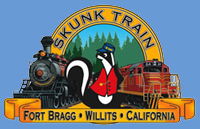
The California Western Railroad, AKA Mendocino Railway, popularly called the Skunk Train, is a rail freight and heritage railroad transport railway in Mendocino County, California, United States, running from the railroad's headquarters in the coastal town of Fort Bragg to the interchange with the Northwestern Pacific Railroad at Willits.
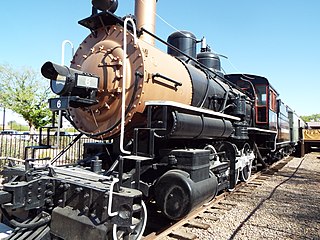
The Magma Arizona Railroad was built by the Magma Copper Company and operated from 1915 to 1997.

The Sumpter Valley Railway, or Sumpter Valley Railroad, is a 3 ft narrow gauge heritage railroad located in Baker County, in the U.S. state of Oregon. Built on a right-of-way used by the original railway of the same name, it carries excursion trains on a roughly 5-mile (8.0 km) route between McEwen and Sumpter. The railroad has two steam locomotives and several other pieces of rolling stock. Passenger excursion trains operate on weekends and holidays from Memorial Day through the end of September.

The Yreka Western Railroad Company is a shortline railroad operating freight trains between the Union Pacific Railroad interchange at Montague and the City of Yreka, California. Railmark Holdings acquired the Yreka Western Railroad in 2017.

The Willamette Valley Railway is a short-line railroad that operates in the Willamette Valley of Oregon. It leased a line from Woodburn to Stayton from the Southern Pacific Transportation Company in February 1993, as well as a branch from Geer west to Salem, and purchased the property in 1996. The company also leased a line between Albany and Mill City in 1993, but transferred the lease to the Albany and Eastern Railroad in October 2000.

The Oregon, Pacific and Eastern Railway is an Oregon-based short line railroad that began near Eugene as the Oregon and Southeastern Railroad (O&SE) in 1904. O&SE's line ran 18 miles (29 km) along the Row River between the towns of Cottage Grove and Disston. The Oregon, Pacific & Eastern Railway Company incorporated in 1912, purchased the physical assets of the O&SE two years later, and shortened their total trackage to operate 16.6 miles (26.7 km) from an interchange yard with the Southern Pacific Railroad at Cottage Grove, east to a 528' x 156' turnaround loop at Culp Creek. The last of this track was closed and scrapped in 1994, and ownership of its abandoned right of way property was later reverted to the state of Oregon to become one of the first-ever Government/Private Sector cooperative partnership Rails to Trails programs in the US, forming the Row River National Recreation Trail. A successor corporation now operates a communications company and a narrow-gauge line at Wildlife Safari.
The 5-mile (8.0 km) Reader Railroad was a tourist-only railroad operating in Reader, Arkansas from 1973 to 1991. As a 23-mile (37 km) common carrier prior to May 1973, it was the last all steam locomotive-powered, mixed train railroad operating in North America. It operated trackage in Ouachita County and Nevada County, Arkansas. The five mile tourist railroad operated until 1991, when it could not meet the new federal safety regulations.

McCloud Railway No. 25 is a 2-6-2 "Prairie" type steam locomotive that worked on the McCloud River Railroad. It was purchased new from the American Locomotive Company (ALCO) in 1925. Shortly after retirement, on July 3, 1955, the No. 25 ceremoniously opened the Burney Branch by bursting through a paper banner with a special excursion train. In 1962, No. 25 was restored for excursion service and served in that capacity until passenger service was once again terminated in 1975. It has since been used in the films Bound for Glory and Stand By Me. It is presently in Oregon, providing excursion service on the Oregon Coast Scenic Railroad.

A forest railway, forest tram, timber line, logging railway or logging railroad is a mode of railway transport which is used for forestry tasks, primarily the transportation of felled logs to sawmills or railway stations.
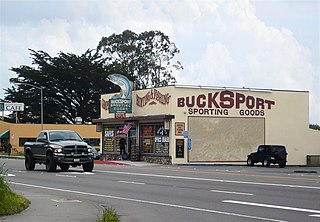
Bucksport was a town in Humboldt County, California. The original location was 2.5 miles (4 km) southwest of downtown Eureka, on Humboldt Bay about 5 miles (8 km) northeast of entrance. at an elevation of 16 feet (4.9 m). Prior to American settlement a Wiyot village named Kucuwalik stood here.
The Caspar, South Fork & Eastern Railroad provided transportation for the Caspar Lumber Company in Mendocino County, California. The railroad operated the first steam locomotive on the coast of Mendocino County in 1875. Caspar Lumber Company lands became Jackson Demonstration State Forest in 1955, named for Caspar Lumber Company founder, Jacob Green Jackson.

The Fort Bragg and Southeastern Railroad was formed by Atchison, Topeka and Santa Fe Railway as a consolidation of logging railways extending inland from Albion, California on the coast of Mendocino County. The railroad and its predecessors operated from August 1, 1885 to January 16, 1930. The line was merged into the regional Northwestern Pacific Railroad in 1907; but planned physical connection was never completed.
Southern Pacific Transportation Company formed the Oregon and Eureka Railroad Company in 1903 in an agreement to use logging railroads as part of a line connecting Humboldt County (California) sawmills with the national rail network. Northwestern Pacific Railroad offered service over the route from 1911 through 1933. The northern 6-mile (9.7 km) of the line remained in use as a Hammond Lumber Company logging branch until 1948.
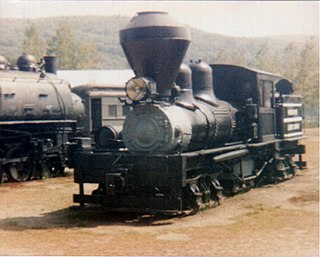
Steamtown, U.S.A., was a steam locomotive museum that ran steam excursions out of North Walpole, New Hampshire, and Bellows Falls, Vermont, from the 1960s to 1983. The museum was founded by millionaire seafood industrialist F. Nelson Blount. The non-profit Steamtown Foundation took over operations following his death in 1967. Because of Vermont's air quality regulations restricting steam excursions, declining visitor attendance, and disputes over the use of track, some pieces of the collection were relocated to Scranton, Pennsylvania in the mid-1980s and the rest were auctioned off. After the move, Steamtown continued to operate in Scranton but failed to attract the expected 200,000–400,000 visitors. Within two years the tourist attraction was facing bankruptcy, and more pieces of the collection were sold to pay off debt.
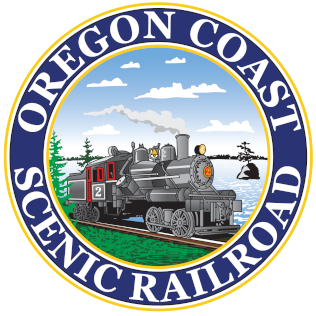
The Oregon Coast Scenic Railroad (OCSR) is a heritage railroad, a 501(c)(3) non-profit organization, operating in Oregon, US, primarily between Garibaldi and Rockaway Beach, with additional special trips to Wheeler, Nehalem River and into the Salmonberry River canyon. The railroad travels on tracks that pass along the edge of Tillamook Bay and the Oregon Coast, and through thick forest along the Nehalem River. The OCSR runs its collection of vintage rail equipment over 46 miles (74 km) of former Southern Pacific Transportation Company track under a lease from the Port of Tillamook Bay Railroad (POTB), an entity distinct from the OCSR. Garibaldi Station is the only station on the system equipped with a wheelchair lift.
Mendocino Lumber Company operated a sawmill on Big River near the town of Mendocino, California. The sawmill began operation in 1853 as the Redwood Lumber Manufacturing Company, and changed ownership several times before cutting its final logs in 1938. The sawmill site became part of the Big River Unit of Mendocino Headlands State Park where a few features of the mill and its associated forest railway are still visible along the longest undeveloped estuary in northern California.

McCloud Railway No. 18 is a 2-8-2 "Mikado" type steam locomotive built by Baldwin Locomotive Works. The locomotive was purchased new by the McCloud River Railway Company in 1914 as a standalone purchase. No. 18 was bought by the Yreka Western Railroad in 1956 and bought back by the McCloud in 1998. It was restored to operation in McCloud during 1998 and operated there until it was sold in 2005 to Virginia and Truckee Railroad.

The Oregon, California and Eastern Railway (OC&E) was a 64-mile (103 km) rail line between Klamath Falls and Bly in the U.S. state of Oregon. After 70 years of bringing logs from nearby forests to local sawmills, the former railroad right of way was converted to the OC&E Woods Line State Trail.
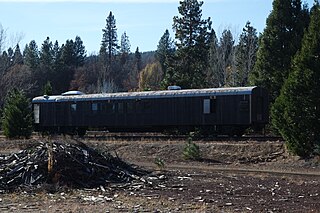
The Shasta Sunset Dinner Train was a scenic dinner train that was operated by the McCloud Railway that started in McCloud, California to Mt. Shasta City from 1996 to 2010. Before 2005, the train also saw service between McCloud and Bartle. After the McCloud Railway abandoned freight operations in 2006, the Shasta Sunset Dinner Train was one of a few passenger trains on the railroad that made a profit for the railroad. The Shasta Sunset Dinner Train ceased operations in 2010 because of the Great Recession with a few passenger cars left on McCloud Railway property.

McCloud River Railroad No. 19, also known as Yreka Western No. 19, or Oregon, Pacific and Eastern No. 19, is a preserved 2-8-2 "Mikado" type steam locomotive in the United States that worked on the Caddo and Choctaw Railroad, United States Smelting, Refining and Mining Company McCloud River Railroad, Yreka Western Railroad, and the Oregon, Pacific, and Eastern Railway. It was purchased new from the Baldwin Locomotive Works (BLW) in 1915. Shortly after retirement, the engine operated on the Yreka Western before being moved up to Cottage Grove, Oregon to run on the OP&E. In the late 1980s, #19 was sent back down to Yreka, California to run on the YW. In April of 1994, the engine returned to McCloud, California to run a series of excursions on the McCloud, Railway. It has since been used in the films Emperor of the North Pole, Bound for Glory, and Stand By Me. As of 2022, No. 19 is being restored at the Age of Steam Roundhouse in Sugarcreek, Ohio.






















